St John's Lutheran Church
Southgate
First organ (in previous church, City Road)
Built 1920s by Welte & Soehne, Freiburg, Germany for the residence of
Mr & Mrs T.J. Noske, 21 (later 39) Irving Road, Toorak
2 manuals, 20 speaking stops, 6 couplers, tubular-pneumatic action with roll-playing mechanism
Installed 1933 St John's Lutheran Church by Hill, Norman & Beard (Australia) Pty Ltd (order no 337).
Rebuilt 1960 by Hill, Norman & Beard (Australia) Pty Ltd (order no V473)
2 manuals, 25 speaking stops, 9 couplers, electro-pneumatic action
Removed from previous church 1990; some pipework survives in other organs
Present organ, built 1991-2 by Knud Smenge
2 manuals, 23 speaking stops, 4 couplers, mechanical action
Chamber organ, built 1996 by Knud Smenge; installed 2001
1 manual, 4 speaking stops, mechanical action
Historical and Technical Documentation by John Maidment
© OHTA, 2013 (last updated September 2013)
The previous church and organ
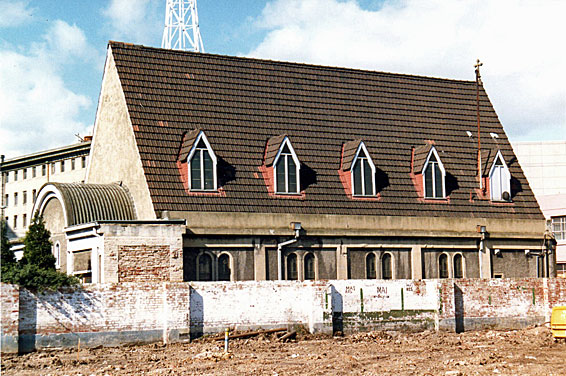
St John's Lutheran Church, City Road, South Melbourne: exterior from the west, just prior to demolition
[photograph by Graham Lieschke (1990)]
The previous St John's Lutheran Church, at 50 City Road, South Melbourne, was designed by architect George Nichterlein in a German arts and crafts style. It was built in 1928 at a cost of £8,000 and opened on Sunday 2 December of that year.1 It was noted in a press report that the door was officially opened by Mr T.J. Noske, who was later to give his residence organ to the church.2 The building included many furnishings of distinctive design and stained glass, some of this preserved in the chapel of the present building.
The Noske family commissioned an organ in the 1920s from the German firm of Welte & Soehne, of Freiburg, for their house at 21 (later 39) Irving Road, Toorak.3 This organ incorporated a roll-playing mechanism. The exact date of the organ cannot be confirmed but an order for roll number 726 (Mozart's Ave Verum) survives in the Welte archives dated "Melbourne 8.2.29".4 An identical organ survives at the Schlosskapelle Meggenhorn, Meggen, Switzerland, dating from 1926. It appears that both instruments were a standard Welte stock model III-IV.5
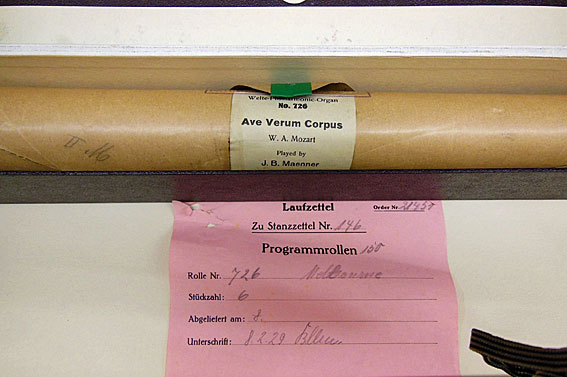
Order slip for Welte organ roll no 726, 1929
[photograph by David Rumsey, courtesy of the Museum der Musikautomaten,
Seewen, Solothurn, Switzerland (2013)]
The organ was donated to St John's Lutheran Church and was installed in a gallery at the church by Hill, Norman & Beard (Australia) Pty Ltd in 1933. A façade of metal dummy pipes enclosed within woodwork, was added in 1944, to screen the swell shutters.
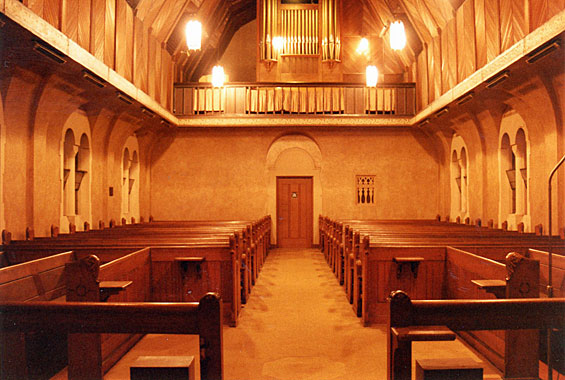
St John's Lutheran Church, City Road, South Melbourne: interior looking towards organ
[photograph by Graham Lieschke (1990)]
The specification of this organ, recorded by Dennis Grieger, was:
| MANUAL I Principal Traversflöte Gamba Viol d'orchestre Vox Celeste [Coelestis] Flöte Fagott Harfe Man I Super Man II zu I Sub Man II zu I Man II zu I Super MANUAL II Principal Traversflöte Bourdon Viol d'orchestre Cor Clarinette Vox Humana Vox Humana echo Oboe PEDAL Subbass Stillgedeckt Flöte [Flötenbass] Man I zu Pedal Man II zu Pedal |
8 8 8 8 8 4 8 8 8 8 8 8 16 8 8 8 16 16 8 |
A B C D A B C E E D F F F |
61 pipes HN&B 1933 61 pipes 61 pipes 61 pipes 61 pipes 61 pipes 61 pipes 61 pipes 42 pipes 42 pipes 61 pipes 30 pipes 12 pipes |
Compass: 61/30
Five fixed combinations: pp, p, mf, f, tutti
One free combination, stops selected by levers over the stopkeys
Pedal to switch off combinations and revert to stopkeys
Tremulant
Balanced swell pedal6
The action of this instrument became increasingly unreliable and it was rebuilt in 1960 by Hill, Norman & Beard (Australia) Pty Ltd with electro-pneumatic action and a detached stopkey console The Welte rolls and roll-playing mechanism were discarded. The specification was evolved between W.A.F. Brodie, the firm's managing-director and Dennis Grieger, St John's organist. It was a very early example of the neo-classical revival which Brodie had experienced in an extensive overseas trip in 1956.
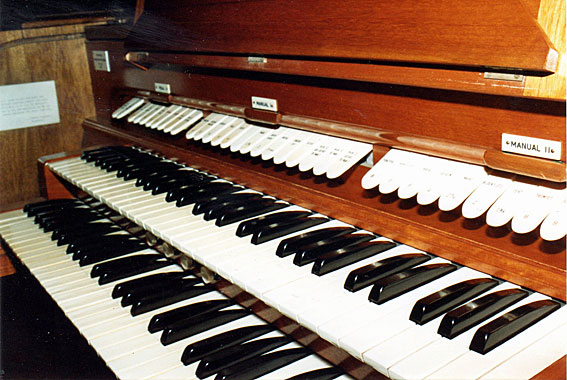
St John's Lutheran Church, City Road, South Melbourne: the Hill, Norman & Beard console
[photograph by Graham Lieschke (1990)]
| MANUAL I Prinzipal Geigend Prinzipal Gedeckt Viola Oktav Koppelflöte Nasat Superoktav Mixtur 22.26.29 Man I Octave Man I Unison Off Man II Sub Octave to Man I Man II to Man I MANUAL II Prinzipal Hohlflöte Viola Geigen Nasat Blockflöte Terz Trompet Schalmei Regal Man II Sub Octave Man II Unison Off Man II Octave PEDAL Sub Bass Still Gedeckt Flöte Oktavflöte Krummhorn Krummhorn Man I to Pedal Man II to Pedal |
8 8 8 8 4 4 2-2/3 2 III 8 8 8 4 2-2/3 2 1-3/5 8 8 8 16 16 8 4 8 4 |
A B C A B C D D D D E E |
old old Gamba old Bourdon old Celeste prepared-for old Traversflöte old Cor with new bass old Viol old Fagott/Oboe old Vox Humana old old Clarinette – papier-mache resonators |
Compass: 61/30
Electro-pneumatic action
Detached stopkey console
Balanced mechanical swell pedal (organ totally enclosed)
Wind pressure 5 inches
Tremulant
4 thumb pistons to Man I
4 thumb pistons to Man II
4 toe pistons to Pedal
Cancel bars to each department
Man I pistons to Pedal
Pedal pistons to Man I7
This organ was dedicated on 7 August 1960.8 The total cost of the work, including alterations to the gallery, was £10,062.9
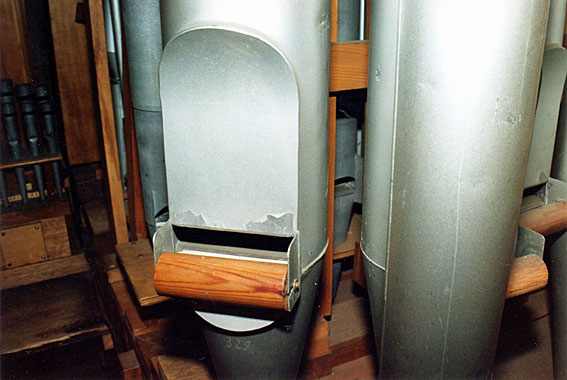
St John's Lutheran Church, City Road, South Melbourne: Welte Principal bass
[photograph by Graham Lieschke (1990)]
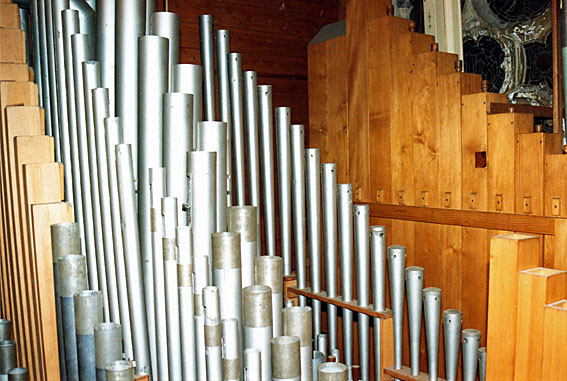
St John's Lutheran Church, City Road, South Melbourne: interior view of organ,
Schalmei and Subbass to the rear
[photograph by Graham Lieschke (1990)]
With the increasing commercialization of the area where this church was placed, and demands for the development of the area, the 1928 church was demolished in 1990. The organ was dismantled and parts have been used elsewhere, seven ranks having been utilized by John Larner in his house organ in Western Australia. The console was used by Australian Pipe Organs Pty Ltd at Trinity Grammar School, Kew.
The present church and organ
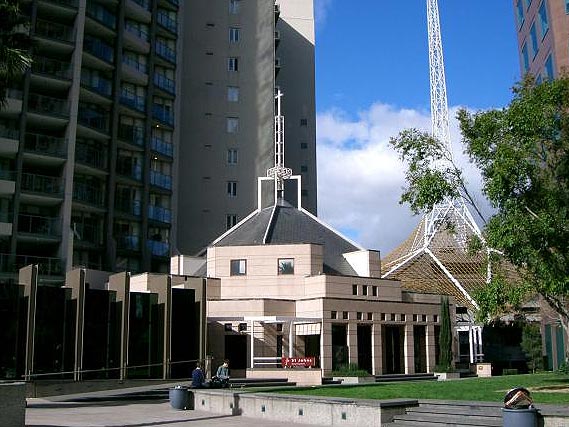
St Johns Lutheran Church, Southgate: the exterior
[photograph by Mark Quarmby (1992)]
The new church of St Johns Southgate was dedicated on 22 March 1992. It was designed by David Cole, an architect from Buchan, Laird and Bawden and links architecturally with the overall Southgate complex.10 It is octagonal in overall shape, with excellent lighting and surrounded by galleries at the upper level. The building is much used for chamber music performance.
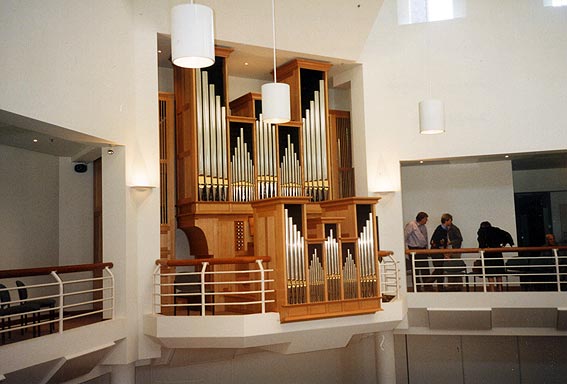
St Johns Lutheran Church, Southgate: the gallery organ
[photograph by Mark Quarmby (1992)]
The organ was built in 1991 by Knud Smenge and the inaugural recital took place on 27 March 1992.11 It includes a Rückpositiv division (one of only four in Victoria, the other three being at Ormond College, Parkville, St Peter's Church, Eastern Hill and Hamer Hall – organ now dismantled and in storage). The tonal design is classical in inspiration but includes a rich variety of unison stops as well as complete choruses and solo mutations. The casework is of Victorian Ash, with Blackwood utilized for the console. The instrument provides a worthy accompaniment to services at St John's Church and its wider musical programme.
| HAUPTWERK (II) Principal Rohrflöte Spitzgamba Octave Querflöte Spitzquinte Waldflöte Mixtur Trompete RP / HW Tremulant RÜCKPOSITIV (I) Holzgedackt Quintadena Principal Koppelflöte Octave Sesquialtera Nasard Scharf Krummhorn Tremulant PEDAL Subbass Principal Gedackt Octave Fagot HW / PED HW OCTAVE / PED RP / PED |
8 8 8 4 4 2-2/3 2 IV 8 8 8 4 4 2 II 1-1/3 III 8 16 8 8 4 16 |
gvd.bass 1998 added late 1992 harmonic from F# 1998 * gvd.bass A B A B |
Compass: 58/30
Mechanical key and stop action
Zimbelstern (6 tuned bells f5 g5 bb5 c6 d6 f6)
* Planned as a Kornet III but insufficient space provided12
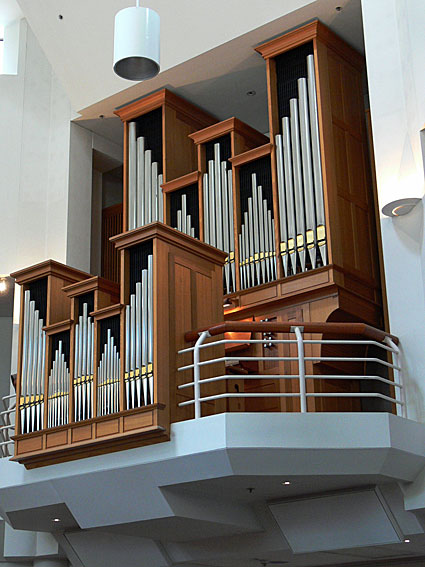
St Johns Lutheran Church, Southgate: the gallery organ
[photograph by John Maidment (21 November 2008)]
A single-manual continuo organ built in 1996 by Knud Smenge was acquired in 2001. This is portable and can be used in close proximity to the groups that perform on the floor at the front of the church. This has a single manual and four stops. The casework is of Jarrah.
| MANUAL Gedackt Rohrflöte Principal Mixtur |
8 4 2 II |
CC-aaa at 440Hz, transposing to 415Hz13
1 Graham Lieschke 'The Organs of St Johns Southgate Lutheran Church', Organo Pleno (September 2001), p.12
2 The Argus 3 December 1928 p. 5
3 Personal communication 1989 Martin Darsoe [grandson of Noske] to John Maidment; see also the following website for information on Noske: http://ruwoldt.wikispaces.com/Johann+Traugott+NOSKE
4 Email communication from David Rumsey to John Maidment 22 August 2013
5 Email communication from David Rumsey to John Maidment 29 August 2013
6 Lieschke, op.cit., p.12; email communication from David Rumsey to John Maidment 29 August 2013, citing the website: http://www.orgelbau.ch/site/index.cfm?fuseaction=orgelbau.orgelportrait&laufnummer=800780&id_art=1193&vsprache=DE with corrections in square brackets to the specification originally noted by Dennis Grieger
7 Lieschke, op.cit., p.13
8 Services on the occasion of the dedication of the organ, 7 August 1960
9 Lieschke, op.cit., p.14
10 Church website: http://www.stjohnssouthgate.com.au/index.php?option=com_content&view=article&id=53&Itemid=62
11 Inaugural organ recital [programme] 27 March 1992
12 Lieschke, op.cit., p.16
13 Details noted by John Maidment
A full history of the organs of St John's Church written by Graham Lieschke 'The Organs of St Johns Southgate Lutheran Church' was published in the journal Organo Pleno for September 2001, pp.12-17. The author is indebted to him and David Rumsey for much of the information in this webpage.